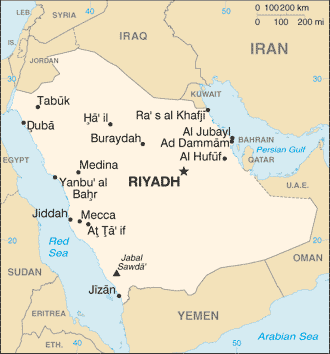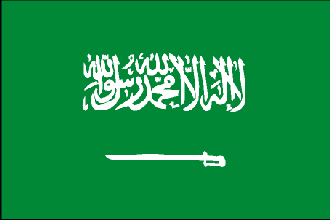
|
Saudi Arabia
Background:
In 1902 Abd al-Aziz Ibn SAUD captured Riyadh and set out on a 30-year campaign
to unify the Arabian Peninsula. In the 1930s, the discovery of oil transformed
the country. Following Iraq's invasion of Kuwait in 1990, Saudi Arabia accepted
the Kuwaiti royal family and 400,000 refugees while allowing Western and Arab
troops to deploy on its soil for the liberation of Kuwait the following year. A
burgeoning population, aquifer depletion, and an economy largely dependent on
petroleum output and prices are all major governmental concerns.
Location:
Middle East, bordering the Persian Gulf and the Red Sea, north of Yemen.
Area: Total: 1,960,582 sq km, water: 0 sq km, land: 1,960,582 sq km.
Area - comparative: Slightly more than one-fifth the size of the US.
Land boundaries: Total: 4,431 km, border countries: Iraq 814 km, Jordan 744
km, Kuwait 222 km, Oman 676 km, Qatar 60 km, UAE 457 km, Yemen 1,458 km.
Coastline: 2,640 km.
Climate and Terrain:
Climate: Harsh, dry desert with great temperature extremes.
Terrain: Mostly uninhabited, sandy desert
Natural resources: Petroleum, natural gas, iron ore, gold, copper.
People:
Population: 23,513,330, note: includes 5,360,526 non-nationals.
Religions: Muslim 100%.
Languages: Arabic,
Government:
Government type: Monarchy.
Capital: Riyadh.
Independence: 23 September 1932 (Unification of the Kingdom.
Economy overview:
This is an oil-based economy with strong government controls over major
economic activities. Saudi Arabia has the largest reserves of petroleum in the
world (26% of the proved reserves), ranks as the largest exporter of petroleum,
and plays a leading role in OPEC. The petroleum sector accounts for roughly 75%
of budget revenues, 45% of GDP, and 90% of export earnings. About 25% of GDP
comes from the private sector. Roughly 4 million foreign workers play an
important role in the Saudi economy, for example, in the oil and service
sectors. Riyadh expects to have a budget deficit in 2002, in part because of
increased spending for education and other social programs. The government in
1999 announced plans to begin privatizing the electricity companies, which
follows the ongoing privatization of the telecommunications company.
GDP - composition by sector: Agriculture: 7%, industry: 48%, services: 45%.
Statistics:
Telephones - main lines in use: 3.1 million.
Telephones - mobile cellular: 1 million.
Radio broadcast stations: AM 43, FM 31, shortwave 2.
Radios: 6.25 million.
Television broadcast stations: 117.
Televisions: 5.1 million.
Internet users: 570,000.
Railways: Total: 1,392 km.
Highways: Total: 146,524 km, paved: 44,104 km, unpaved: 102,420 km.
Airports: 209, with paved runways: 71, with unpaved runways: 138.
Heliports: 5.
Return to Visiting Locations
|

